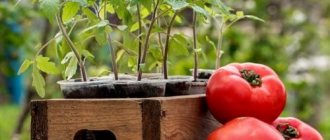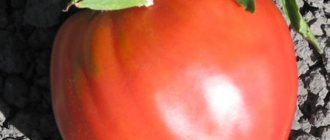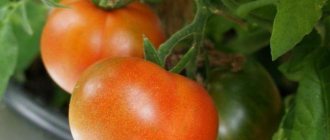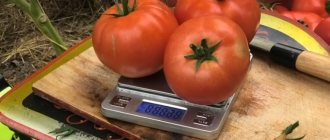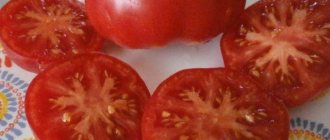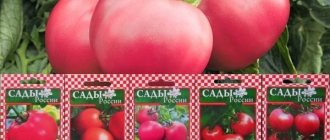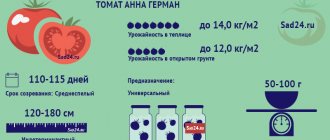Classic F1 is a highly productive hybrid from the Dutch tomato line. Tomato is cultivated in different climatic zones. In northern conditions, in Siberia, in the Central region, greenhouse facilities are required for cultivation. In Crimea, Stavropol, Krasnodar, the hybrid is cultivated in open areas.
| Height | Landing location | Ripening time | Fruit color | Fruit size | Origin | Fruit shape |
| short | Greenhouse, Open ground | Early ripening | Reds | Average | Hybrid | Plum-shaped or oval |
Description of tomato Classic f1
The Classic f1 hybrid was selected by the Dutch company Nunhems in 2003. The variety has been listed in the State Register of Russia since 2005. Recommended areas for growing the variety are located in the North Caucasus District, Krasnodar and Stavropol regions. The tomato is suitable for cultivation in Crimea.
Comment! The domestic market offers Classic f1 tomato seeds from Chinese, Dutch and Russian breeders, produced using technology purchased from the originator.
Classic tomatoes are early ripening crops. Under favorable conditions, the first fruits are harvested 90 days after planting the seeds. Lack of lighting and nutrition of the bushes delays ripening by 10–15 days.
The determinant properties of the bush are reflected in its growth. Classic tomatoes, depending on the shape, reach from 50 to 100 cm in height. Like all standard varieties, the tomato is distinguished by thick stems that are not prone to lodging.
The leaves are strongly corrugated, medium in size with small fluff and short petioles. The bush is compact. The first flowers appear after the 6th leaf. Further along the stem, the clusters are formed densely - through one or two leaves. In the south of the country the bush is formed into 4 sleeves. In the middle zone and in greenhouse conditions, no more than 3 stems are left.
Description of fruits
Varietal characteristics of tomato fruits Classic F1:
- tomato shape: round, plum-shaped, slightly depressed at the stalk;
- color: at consumer maturity, dark red with a scarlet tint;
- taste: characteristic “tomato”, pronounced, sweetish;
- weight: from 60 g, the first copies can reach 100–110 g;
- number of cameras: from 3 to 5;
- dry matter: 5–6%.
Ripening of Classic f1 tomatoes in the hand occurs evenly, making it easy to harvest. Fleshy tomatoes with dense pulp tolerate transportation well.
Features and differences of tomatoes
Tomatoes are among the most common vegetables to grow. They contain a lot of useful elements, in particular lycopene, a powerful antioxidant that reduces the risk of formation and prevents the proliferation of cancer cells.
Tomatoes also contain a large amount of vitamins and microelements necessary for humans: serotonin, phytoncides, chromium. Serotonin is a well-known “happy” hormone that improves mood. Phytoncides are plant substances that inhibit bacterial growth. And chromium promotes rapid saturation, which, by the way, makes tomatoes an excellent product for dietary nutrition.
There is a theory that foods that are similar to a certain part of the body have a positive effect on that organ. So, heart-shaped tomatoes reduce the risk of developing cardiovascular diseases. In addition, they improve digestion and are useful for asthenia, atherosclerosis, and azotemia.
But not all people can eat tomatoes. For example, they are contraindicated for older people suffering from bone and joint diseases. This is due to the fact that frequent consumption of tomatoes leads to the accumulation of calcium and salts in the body. Therefore, excessive consumption of tomatoes is contraindicated for all people. It is recommended to eat no more than 200 g of this vegetable per day.
Another disadvantage is that tomatoes contain a large amount of acids. They can provoke spasm of the gallbladder.
There are several types of tomatoes. Let's look at this issue in more detail.
Determinant
Determinate – varieties whose growth is limited. These tomatoes have many advantages:
- limited upward growth involves the development of strong lateral stepsons that bear fruit, which makes such varieties high-yielding;
- one-time fruiting - determinate tomatoes produce a large harvest that does not stretch over time;
- early fruit ripening;
- adapt well to open ground;
- limited growth spares the gardener from tying up and replacing supports.
But the variety also has some disadvantages:
- limited growth leads to limited yield, that is, the yield is lower than that of indeterminate varieties;
- low resistance to diseases.
The most famous determinate varieties of tomatoes are Sakhalin, Ladies' Man, King of Early and Golden Heart.
Indeterminate varieties can grow very tall
Indeterminate
Indeterminate varieties have unlimited growth. They also have certain advantages:
- high yields from a small area of land - due to the high growth of individual plants;
- long fruiting period: in open ground they produce crops until the weather gets cold;
- resistant to most diseases.
But we cannot help but note some disadvantages:
- large growth requires special care: plants must be constantly tied up using high supports, good lighting and air exchange must be provided;
- it is necessary to remove all the stepsons so that the nutrients go to the formation of the main stem;
- They perform well in greenhouses, but in open ground in regions that are not hot enough they ripen quite late and bear less fruit.
Indeterminate tomatoes include such popular varieties as Babushkin Secret, Bull's Heart and Chernomor.
Standard
These are compact plants with one short and thick stem. They do not require specific care: no need to pin or tie them up. They produce a good harvest, but the tomatoes are usually small.
Standard tomatoes include Snow White, Riddle and Moskvich.
Superdeterminant
Superdeterminate tomato varieties are the fastest ripening. They are ideal for those who want to get an early harvest without much effort.
These varieties do not require pinching. Also, due to its short stature, a garter is not needed. The downside is that, after harvesting once, you can’t expect more fruits from super-determinate varieties.
Popular varieties of superdeterminate tomatoes are Children's Sweetness, Alaska and White Bulk.
Semi-determinate tomatoes
Semi-determinate varieties combine the properties of determinate and indeterminate varieties. They have an average height, which allows you to harvest a large harvest from one plant, but without putting in much effort, tying and pinching the bush. In this case, the fruits are formed throughout the growing season.
It is preferable to grow such tomatoes in greenhouses.
The most popular hybrids of this type of tomato are Yvette F1, Gravity F1, Red Arrow F1.
Characteristics of tomato
The best results are obtained by cultivating Classic tomatoes in open ground, under the southern sun. But the hybrid tomato is also suitable for greenhouses. A low, weakly branching tomato bush is suitable for growing under small film covers and does not take up extra space in greenhouses.
Productivity and fruiting
Early ripening allows, when grown in open beds, to obtain the first harvest simultaneously with greenhouse varieties. With the care recommended by the tomato aggregator, the yield reaches 4 kg per plant. The compactness of the medium-sized bush allows planting at a density of up to 5 specimens per 1 square meter. m., which gives a total yield of about 20 kg.
The fertility of the Classic variety is most influenced by the timeliness of fertilizing and regularity of watering. Therefore, with due attention, tomato shows the same high yield in protected soil.
Area of application of fruits
Small, beautifully shaped fruits are very convenient for home canning and industrial harvesting. The high content of dry substances allows tomatoes to be processed into tomato paste, ketchups, and sauces.
When sliced as part of complex dishes, Classic does not lose its shape, does not flow and tolerates heat treatment well. Whole tomatoes are suitable for pickling in barrels, pickling, and pickling.
A long shelf life without loss of presentation allows the Classic f1 variety to be grown in large volumes for sale. The variety has excellent transportability.
Resistance to diseases and pests
As a result of successful selection, the Classic f1 tomato has acquired resistance to viral and bacterial infections common to tomatoes.
The variety is immune to the following infections:
- bacterial spot;
- fusarium wilt;
- verticillium;
- nematode.
Tomato is relatively resistant to late blight. Therefore, preventive treatments for tomatoes are recommended to be carried out regularly. It is worth monitoring soil and air humidity: during rainy periods or with excessive watering, plants can be damaged by fungal diseases. Tomatoes growing indoors are especially vulnerable to infection.
Advantages and disadvantages of the variety
Gardeners who have been familiar with Classic F1 tomatoes for many years note the following positive qualities of the hybrid:
- consistently high productivity;
- excellent commercial quality;
- ability to tolerate temporary drying out of the soil;
- rapid germination of seeds and the possibility of sowing in open ground;
- insensitivity to daily temperature fluctuations;
- resistance to infections.
The noted disadvantages of the variety include the need for constant feeding throughout the season. According to reviews, Classic tomatoes do not tolerate proximity to other tomatoes. Some gardeners call the disadvantage of the hybrid the tendency of the fruits to crack due to irregular watering. But this deficiency can be corrected by competent agricultural technology.
Yield varieties of tomatoes in 2022
Varieties that are most often planted in open ground are standard varieties with the shortest possible ripening time. Among them the following stand out:
- Red Fang has elongated tomatoes weighing up to 60 g, but about 3 kg of harvest can be harvested from the bush;
- Gina, which will produce fruit weighing about 200 g, with each bush having a yield of 4 kg;
- Lojain promises slightly larger tomatoes, and a higher yield (8 kg), while it is characterized by increased resistance to drought.
In most of Russia, tomatoes are grown only in greenhouses. Therefore, you also need to know such new varieties of tomatoes for 2021
Gardeners can pay attention to the following names of early tomatoes:
- Tornado F, with proper care, can please gardeners with a harvest of 8 kg;
- Empire F will produce small fruits weighing up to 140 grams in the form of cream;
- Samurai is distinguished by its pink color; a tomato weighing 200 g will produce a yield of about 4 kg;
- De Barao are characterized as tomatoes with fruits weighing 100 g, which yield a yield from a bush of 4 kg;
- Verlioka+ F is characterized as disease resistant;
- Yakimanka F bears fruit with tomatoes weighing about 230 g.
New varieties of tomatoes recommended by breeders
- Watercolor. A variety that will produce a harvest within 100 days. Tomatoes are oval in shape and weigh from 80 to 120 g. Therefore, they are excellent for pickling. The undoubted advantage of these tomatoes is their good transportability and long shelf life.
- Alsou. It is a universal tomato for growing, since it can grow both in open ground and in a greenhouse. In the first case, it will grow 80 cm from the ground, and in a closed greenhouse it will stretch up to 1 m 20 cm. Its tomatoes grow weighing from 600 g to 1 kg. A good yield of tomatoes will allow you to eat plenty of fresh salads. Due to their size, they are not suitable for canning.
- Dimensionless. The name speaks for itself: its fruits weigh from 1 kg. It can be grown in open beds and greenhouses. The advantage of a tomato is its ability to sit for a long time. Moreover, the fruits do not crack when ripe.
Growing rules
All varietal characteristics of Classic F1 are fully revealed in the southern regions, when cultivated in open ground. In central Russia, film coverings are used for tomatoes. In harsher climates, the variety can only be grown in heated greenhouses.
Traditionally for Russia, growing tomatoes through seedlings. According to reviews from southern gardeners, Classic f1 seeds can be planted directly in open ground. They germinate well and develop quickly in warm climates. But for other areas, the seedling method is the only possible one.
Planting seedlings
F1 tomato hybrids do not transmit varietal characteristics through seeds. Therefore, you need to purchase planting material every year. Manufacturers most often allow already processed seeds for sale, which is indicated on the packaging. If there is no such marking, then it is advisable to keep the tomato seeds in the stimulator for 12–18 hours.
Attention! It perfectly disinfects and enhances seed germination by immersing them in aloe juice, diluted with clean water in a 1:1 ratio. Soak the material for at least 6 hours.
Features of growing tomato seedlings Classic f1:
- The sowing time is calculated so that by the time the seedlings are ready (on the 60th day), the soil in the beds has warmed up sufficiently and air temperature fluctuations have leveled out.
- For planting, you need a loose, fertile substrate with good breathability.
- Sow immediately into separate containers. The Classic variety takes root better and yields faster if the seedlings have not been picked.
- After the first shoots, the plants need maximum lighting, and it is advisable to reduce the air temperature for 3–4 days.
The Classic f1 variety needs constant feeding, so complex fertilizers are applied every 14 days. Dilute the irrigation solution by adding twice as much water as indicated in the instructions for open ground.
Tomato transplant
Before planting in a permanent place, the seedlings are hardened off for several days and transferred only to warm, heated soil. In areas where the Classic f1 tomato is not zoned, it is better to grow it in a greenhouse or under film covers.
The variety prefers loamy soils, however, the beds must be well fertilized. If the soil contains a lot of sand, it is further compacted by adding clay substrates.
Standard planting of standard tomato varieties is shown in the photo. Classic F1 can be thickened with up to 5 plants per square meter, without loss of productivity.
The holes for tomato seedlings are much larger than the size of the root system. The variety benefits from deepening when planting until the first leaves.
Subsequent care for tomatoes
The usual care for the Classic hybrid, which consists of weeding, hilling the bushes, and pinching, does not differ from the techniques for other varieties of tomatoes. But there are differences specific to this variety.
Classic f1 tomato bushes are strong and low, but the growing harvest is always abundant and can damage the branches. The plant must be tied to an individual support or a common trellis. In a temperate climate zone and in a greenhouse, a tomato is formed into 2, less often 3, stems. In the south, 4 branches are left.
Enhanced growth and increased yield require constant feeding. The Classic variety is fertilized every 10 days with a full mineral composition, alternating with organic matter (bird droppings, ash, humus). Increase fertilizing during flowering and increasing fruit size. It is important to ensure that potassium and phosphorus compounds are present in the compositions.
The watering regime is very important for Classic f1 tomatoes. The bushes tolerate short-term droughts well, but the quality and quantity of the harvest is greatly reduced. If irrigation is not regular, tomatoes are prone to cracking. Therefore, hydration should be periodic and deep. The best method of watering for such tomatoes is drip systems.
Planting and care
You can start sowing from the end of February. The active planting season lasts until the end of March.
Tomato “Semko” Fifty has prepared and processed seeds that do not need to be treated with disinfectant solutions or soaked in stimulants.
There are certain requirements for the soil mixture. It must be disinfected, and also be loose and fertile.
To do this, it is prepared based on the following components:
- turf;
- compost;
- sand;
- wood ash.
How to plant correctly:
- Sowing is carried out in peat tablets, cups or boxes.
- The soil substrate is preliminarily moistened moderately.
- Plant the seeds to a depth of 2 cm.
- Distribute at a distance of 3 cm.
- Water and sprinkle.
- Cover the top of the containers with polyethylene.
Until complete germination and emergence of seedlings on the surface, keep the boxes covered with film. Recommended tomato varieties
Taimyr User rating: 5/5
Dunyasha User rating: 4/5
Gift of the Volga pink User rating: 4/5
Banana red User rating: 4.5/5
Pest and disease control
A resilient hybrid crop can withstand most diseases, provided it receives regular (but not excessive) watering and adequate nutrition. Timely application of fertilizers can replace disease prevention.
Special preparations are used against insects:
- from a gnawing scoop - “Arrow”;
- against the Colorado potato beetle - “Prestige”;
- Adding tobacco ash to the soil helps prevent slugs.
Important! A good way to prevent late blight is to use open containers of iodine placed in the greenhouse. The evaporation will prevent harmful microorganisms from multiplying.
Diseases
When the humidity in the greenhouse is high, you can sometimes see small cracks on the tomatoes. To prevent this from happening, it is necessary to regulate the humidity in the greenhouse. To do this, after watering or if a lot of water accumulates in the greenhouse after rain, you need to open the sides and ventilate the air so that it does not steam so much.
To prevent a tomato from getting fungal diseases, it is necessary to regulate:
- watering mode;
- greenhouse illumination;
- application of fertilizers.
Inspect your greenhouse at least once a week for diseases and remove diseased bushes so that the disease does not spread to the rest of the plantings. Destroy the affected parts of plants outside the site.
Early fleshy varieties of indeterminate tomatoes
Indeterminate varieties of tomatoes do not stop growing throughout the growing season. Because of this, they turn out to be very tall. Another advantage of indeterminateness is that the bushes bear fruit all season long.
The disadvantage is that the plant bears fruit a little at a time. That is, the harvest will be extended over a long time.
Among the early, fleshy varieties of indeterminate varieties, you can pay attention to the following varieties
Wonder of the earth
A variety with large fruits that look like a human heart.
On average, one fruit weighs at least half a kilo.
Productivity – 4 kg per plant.
It is easy to care for.
Requires garter as it grows up to 2 m in height.
Abakan pink
A fairly well-known tomato is relatively large, fleshy tomatoes that ripen early.
The weight of one copy reaches 300 g.
The “tomatoes” themselves are pinkish and elongated in shape.
Good transportability.
Red giant
A variety with more than 30 years of history.
Fruits well in protected soil.
The largest fruits weigh more than 600 grams.
The pulp is juicy and tasty.
Grows confidently in the latitudes of the Middle Zone and Moscow region.
Description and characteristics of the variety
Tomato Classic F1 belongs to the Nunhems line from Holland, bred in 2003, included in the State Register since 2005. The tomato is an early ripening species. The first harvests are harvested 95-105 days after germination.
Among the characteristic features of the hybrid:
- precocity;
- versatility;
- growth is determinant;
- low-growing bushes (height 50-60 cm);
- moderate branching and foliage.
The plum-shaped small fruits have a balanced taste and are in constant demand.
- average weight 80-110 g;
- shape like a plum;
- the flesh is fleshy, moderately juicy;
- consistency is dense;
- the taste combines sourness and sweetness;
- The skin is thin, durable, and does not crack.
Tomatoes are cut into fresh dishes, juices and sauces are prepared from them, and they are canned whole.
Advantages and disadvantages
Experts include the main advantages of the Verochka tomato:
- early ripening of the crop;
- high yield for a determinate low-growing variety;
- the possibility of growing Verochka tomato in open ground and in a greenhouse in most Russian regions;
- the fruits are not prone to cracking due to the compacted skin, so they tolerate heat treatment well, maintaining a beautiful appearance when pickled and salted;
- the harvested crop can be transported to any distance and stored in a cool place for a long time;
- thanks to increased immunity, the Verochka tomato is resistant to many diseases;
- the Verochka tomato is resistant to sudden fluctuations in weather conditions, as well as heat, which makes it possible to grow this hybrid in the south of Russia;
- the collected fruits are of universal use.
The Verochka tomato has virtually no downsides. Except for the fact that it will not be possible to collect seeds from the fruits of the hybrid and they have to be purchased annually in specialized stores.
The best tall varieties for open ground
Varieties and hybrids differ according to purpose, care requirements, and yield. Some bear fruit only in the southern regions, others also manifest themselves in the middle zone.
Cardinal
Plant height is about 1.5 m, leaves are medium sized, wide. The bush is powerful and requires tying to a support and pinching. The tomatoes are heart-shaped, raspberry-red in color, sugary.
There are few seeds, the pulp is juicy and sweet. The weight of the fruit varies from 300 to 500 g; about 5 kg of crop is harvested from 1 bush. The variety is used for preparing salads or slicing vegetables.
Pink Elephant
The large-fruited and heat-resistant Pink Elephant is grown on loose and fertile lands. The tomatoes are round, slightly flattened. The color is pink-red, the skin is glossy. The weight of the fruit is about 250 g, the pulp is dense and fleshy. From 1 m², gardeners receive from 6 to 9 kg of vegetables.
In use, Pink Elephant is universal, suitable for fresh consumption and for preparing salads, winter preparations, and sandwiches. The fruits of the Pink Elephant are shown in the photo below.
Tomato "Pink Elephant"
Wonder of the earth
The bushes grow up to 1.5 m, suitable for growing in open ground and in a greenhouse. The miracle of the earth is resistant to sudden changes in weather - frost, rain, fog. Tolerates heat and drought. Color - rich pink.
The skin is dense and glossy, thanks to which the tomatoes have good keeping quality and are suitable for long-term storage. The shape of the fruit is heart-shaped, weight from 150 to 200 g. The taste is sweet, the variety is universal in use. From 8 to 14 neat tomatoes ripen on one bush.
Tomato "Miracle of the Earth"
De Barao
The indeterminate high-yielding variety is not limited in growth, so timely staking and pinching is required. Late-ripening De Barao ripens 115 days after the appearance of the first shoots. The tomatoes are compact, average weight 80 g. Oval in shape, thick, glossy skin. The taste is balanced, sweet and sour. Productivity is about 8 kg per 1 m².
Tomato "De Barao"
Barmaley
The plant is massive, up to 2 m high. The early tall Barmaley bears fruit 100 days after emergence and requires staking and pinching of the top. The tomatoes are flat-round, weight varies from 200 to 300 g. The skin is smooth, the flesh is juicy and sugary. The color is light pink, there are few seeds.
Barmaley can be transported over long distances without consequences, is perfectly stored, and is universal in use. The productivity is high - about 16 kg of tomatoes are obtained from 1 m².
wild Rose
Wild rose ripens in 110-115 days. Suitable for growing in temperate regions. The fruits are round in shape and pink in color and have attractive commercial qualities. Tall bushes are pinched and tied to a support. The average weight of a tomato is 400 g; the variety is universal in use.
The taste is sweetish, the flesh is dense. About 6 kg of tomatoes are harvested from 1 m². Some are consumed fresh, some are stored for storage.
wild Rose
Watch this video on YouTube
Anniversary Tarasenko
A mid-season indeterminate variety ripens in 115-120 days. The height of the bush is 170 cm. It has an original shape - round tomatoes with a pointed nose, weight 80 g.
Jubilee Tarasenko is resistant to diseases and pests, but is picky about the condition of the soil. Vegetables make delicious salads and canned winter preparations. The taste is sugary, the flesh is fleshy. Productivity 15 kg per 1 m².
Tomato "Anniversary Tarasenko"
China Gold
The early ripening variety ripens in 85-90 days. The tomatoes are perfectly even and smooth, golden-orange in color. The taste is sweet and soft. The weight of a tomato is 150-200 g; vegetables are consumed fresh. The Chinese Gold variety is popular in Russia and the CIS countries. Productivity 4 kg from 1 bush.
Mikado pink
Ripens in 95-105 days from the moment the first shoots appear. The bushes are indeterminate, height from 1.5 to 1.8 m. Pink Mikado needs pinching and bush formation.
The fruits are flat-round, weight varies from 200 to 300 g, in some cases reaching 600 g. The color is red-raspberry, the taste is sweet and juicy, the peel is smooth. Productivity 11 kg per 1 m². Mikado pink is suitable for making soups, tomato paste and juice.
Tomato "Mikado pink"
Honey saved
The salad variety Honey Saved is easy to care for, but requires shaping and tying to a support. Productivity 5 kg per bush. The shape is spherical, the color is golden-orange. The weight of the fruit varies from 200 to 600 g. Honey spas is resistant to late blight and root rot, and is immune to weather changes.
It is recommended to consume the crop fresh or as a chopped vegetable. Vegetables are not suitable for long-term storage.
Tomato "Honey Spas"
Features of agricultural technology
Tomato Verochka does not require much attention, but to obtain the desired result, you must follow the following growing rules:
- Seeds are sown for seedlings 50-55 days before the planned planting in the ground.
- The tomato is low-growing, but the stems break under the weight of the harvest. Supports should be installed simultaneously with planting. How to tie up tomatoes correctly, read here.
- 4-5 bushes are placed per 1 m².
- A tomato growing in a garden bed is formed into 2 or 3 stems. Leave all the brushes on the main one. To form 2 and 3 additional stems, well-developed stepsons are used. The rest are removed every week. Find out more about the stepson procedure in this detailed article.
- In a greenhouse, superdeterminate varieties often form one stem.
Caring for a hybrid is not particularly different from working with other varieties.
Attention! Although tomato is resistant to common diseases, preventive measures should not be neglected
Advantages and disadvantages
Tomato has many positive qualities, including:
- Resistance to lack of moisture. This feature makes the plant a favorite of those who visit the dacha only on weekends. After all, in hot weather, even if the tomatoes are not watered, they will not die.
- Fast maturation. One hundred days after the emergence of seedlings, you can get the first harvests of delicious, sweetish tomatoes.
- Resistant to sudden temperature changes. This property allows the hybrid to be planted earlier than other varieties.
- High stable yield. With proper care, “Classic” shows good results.
Despite all the advantages, there are also disadvantages. Among them, it is worth noting the capriciousness of fertilizing and poor compatibility with other varieties.
